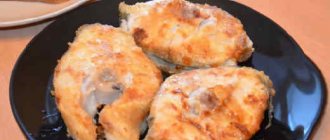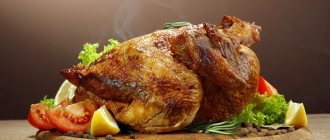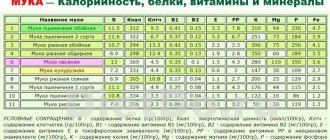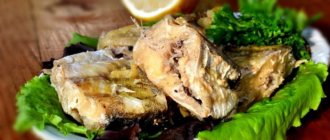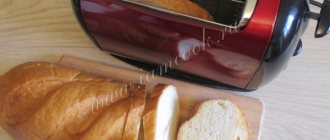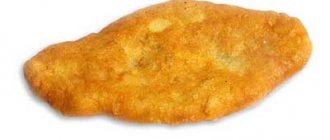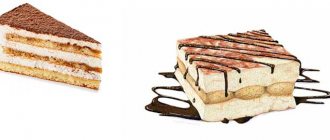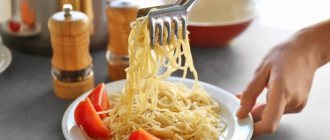Calculation of caloric content of a product per 100 grams
The calculation of the calorie content of 100 grams of product is based on previously known indicators of BZHU (abbreviation: proteins-fats-carbohydrates). The calculation method is the summation of these data (obtained by laboratory analysis and calculations) previously multiplied by a value equal to the energy released (calories) during their splitting. So, for example, 1 gram of protein or carbohydrate can release energy equal to 4.1 kcal, and fat a little more than 9. In calorie calculations, these numbers are usually rounded to whole numbers, as is the result itself.
Our example involves proteins - 17.2 grams and fats - 0.5 grams, contained in 100 grams of product. Next we perform the calculation:
Energy value of 100 grams = 17.2 (proteins)*4 + 0.5 (fat)*9 = 68.8 + 4.5 = 73.3 kcal
Our calculated calorie content is more than 50, but less than 250 kcal, which means that haddock is a medium-calorie product with a high protein content and a low amount of fat and carbohydrates.
Features of haddock
This is a marine fish that lives mainly in the waters of the North Atlantic, as well as in the Barents Sea.
Haddock can grow up to 1 meter in length and gain weight up to 15 kilograms. However, the average size of haddock is up to 50 cm in length and weighs from 3 to 5 kilograms.
It belongs to the cod fish species, so there is a certain similarity. This is indicated by oval spots located on the sides of the fish. Haddock meat is characterized as white and dense, retaining its elasticity during heat treatment.
Haddock meat goes well with many spices and products, so various dishes are prepared from it, including restaurant ones. It can be consumed fresh, smoked and dried. But, mostly, it is found fresh frozen on the market. Haddock is especially tasty if you pickle it fresh.
Benefits of haddock
Many people prefer to buy and eat fish meat because it is much healthier than other meat of animal origin. Fish meat contains a sufficient amount of vitamins and microelements that have a positive effect on the human body. Fish is well digestible due to the fact that it does not contain a protein called elastin.
Haddock meat is not fatty, so it is perfect for dietary nutrition. This suggests that it will be useful for those who decide to lose weight. The main part of the fat, as in most fish, is concentrated in the liver of the fish, therefore, fat is rendered from the liver under industrial conditions.
Fish oil is generally used in medicine. Cod liver (including haddock) is a valuable food product. In this regard, canned liver-based products can be found on sale. The liver contains polyunsaturated fatty acids omega-3, which have a beneficial effect on the functioning of the central nervous system, vision and reduce cholesterol levels in the blood. With constant consumption of haddock meat, the body is saturated with selenium, which helps improve the absorption of substances.
Regular consumption of fish meat can actually improve the condition of hair, nails, skin and mucous membranes. Haddock meat is especially useful for pregnant women and people weakened as a result of serious illnesses.
Contraindications and harms of haddock
It is not recommended to eat haddock for those people who have allergic reactions to seafood. As a result of the consumption of haddock by such people, anaphylactic shock is possible, which leads to serious conditions. This happens due to the body’s reaction to the protein contained, in this case, in fish. The human immune system, mistakenly, for unknown reasons, perceives this protein as dangerous to health, which is why allergies occur.
There are also people who cannot tolerate fish products in general, or rather, their digestive system due to a lack of certain enzymes. This phenomenon may occur the first time seafood is consumed, unlike an allergy that occurs upon repeated consumption.
In fact, such disorders are quite rare, and seafood meat has only a positive effect on the human body.
Vitamin content
Table 1
| Vitamins | Content | Daily norm |
| C (ascorbic acid) | 0.8 mg | 1.14 % |
| A (retinol) | 10 mcg | 1 % |
| E (α-, β-, γ-tocopherols) | 0.3 mg | 3 % |
| D (lamisterol) | 0.5 mcg | 20 % |
| B1 (thiamine) | 0.09 mg | 6 % |
| B2 (riboflavin) | 0.15 mg | 8.33 % |
| B3 (PP) (nicotinamide) | 6 mg | 31.58 % |
| B4 (choline) | 65 mg | 13 % |
| B6 (pyridoxine) | 0.28 mcg | 14.05 % |
| B9 (folacin) | 12 mcg | 6 % |
| B12 (cobalamin) | 1.83 mcg | 61 % |
Haddock contains high, medium and low levels of vitamins when considered according to approved nutritional significance standards.
At the highest level of importance in the food value chain are:
- D, takes part in the formation of bone and dental tissue.
- PP, participates in the formation of hemoglobin.
- B4, is involved in the biosynthesis of heme and proteins, cell proliferation, and tissue respiration.
- B6, participates in the metabolism of lipids and amino acids.
- B12 is involved in many metabolic processes in the body.
Vitamins at a medium level of importance include:
- B1, required to normalize the nervous and muscular systems.
- B2, maintains body tone.
- B9, supports the hematopoietic and digestive system.
Vitamins of low content include:
- C, takes part in the redox processes of the body, raises the tone of the body, strengthens the immune system.
- A, takes part in all functions of the body related to its growth and proper metabolism, preserves the structure of the cornea of the eye.
- E, keeps the muscular system in good shape.
Recipe for haddock fried in flour. Calorie, chemical composition and nutritional value.
Nutritional value and chemical composition of “haddock fried in flour”.
The table shows the nutritional content (calories, proteins, fats, carbohydrates, vitamins and minerals) per 100 grams of edible portion.
| Nutrient | Quantity | Norm** | % of the norm in 100 g | % of the norm in 100 kcal | 100% normal |
| Calorie content | 119.6 kcal | 1684 kcal | 7.1% | 5.9% | 1408 g |
| Squirrels | 16.8 g | 76 g | 22.1% | 18.5% | 452 g |
| Fats | 3.4 g | 56 g | 6.1% | 5.1% | 1647 g |
| Carbohydrates | 5.5 g | 219 g | 2.5% | 2.1% | 3982 g |
| Alimentary fiber | 0.4 g | 20 g | 2% | 1.7% | 5000 g |
| Water | 73.2 g | 2273 g | 3.2% | 2.7% | 3105 g |
| Ash | 1.291 g | ~ | |||
| Vitamins | |||||
| Vitamin A, RE | 8.3 mcg | 900 mcg | 0.9% | 0.8% | 10843 g |
| Retinol | 0.008 mg | ~ | |||
| beta carotene | 0.001 mg | 5 mg | 500000 g | ||
| beta Cryptoxanthin | 0.155 mcg | ~ | |||
| Lycopene | 0.019 mcg | ~ | |||
| Lutein + Zeaxanthin | 0.661 mcg | ~ | |||
| Vitamin B1, thiamine | 0.087 mg | 1.5 mg | 5.8% | 4.8% | 1724 g |
| Vitamin B2, riboflavin | 0.128 mg | 1.8 mg | 7.1% | 5.9% | 1406 g |
| Vitamin B4, choline | 4.23 mg | 500 mg | 0.8% | 0.7% | 11820 g |
| Vitamin B5, pantothenic | 0.024 mg | 5 mg | 0.5% | 0.4% | 20833 g |
| Vitamin B6, pyridoxine | 0.015 mg | 2 mg | 0.8% | 0.7% | 13333 g |
| Vitamin B9, folates | 2.218 mcg | 400 mcg | 0.6% | 0.5% | 18034 g |
| Vitamin C, ascorbic acid | 0.6 mg | 90 mg | 0.7% | 0.6% | 15000 g |
| Vitamin E, alpha tocopherol, TE | 1.71 mg | 15 mg | 11.4% | 9.5% | 877 g |
| gamma tocopherol | 0.015 mg | ~ | |||
| Vitamin H, biotin | 0.161 mcg | 50 mcg | 0.3% | 0.3% | 31056 g |
| Vitamin K, phylloquinone | 0.5 mcg | 120 mcg | 0.4% | 0.3% | 24000 g |
| Vitamin RR, NE | 6.4256 mg | 20 mg | 32.1% | 26.8% | 311 g |
| Niacin | 2.724 mg | ~ | |||
| Betaine | 0.029 mg | ~ | |||
| Macronutrients | |||||
| Potassium, K | 245.79 mg | 2500 mg | 9.8% | 8.2% | 1017 g |
| Calcium, Ca | 20.51 mg | 1000 mg | 2.1% | 1.8% | 4876 g |
| Silicon, Si | 0.323 mg | 30 mg | 1.1% | 0.9% | 9288 g |
| Magnesium, Mg | 25.42 mg | 400 mg | 6.4% | 5.4% | 1574 g |
| Sodium, Na | 168.6 mg | 1300 mg | 13% | 10.9% | 771 g |
| Sera, S | 202.35 mg | 1000 mg | 20.2% | 16.9% | 494 g |
| Phosphorus, P | 156.2 mg | 800 mg | 19.5% | 16.3% | 512 g |
| Chlorine, Cl | 364.48 mg | 2300 mg | 15.8% | 13.2% | 631 g |
| Microelements | |||||
| Aluminium, Al | 84.7 mcg | ~ | |||
| Bor, B | 3 mcg | ~ | |||
| Vanadium, V | 7.26 mcg | ~ | |||
| Iron, Fe | 0.81 mg | 18 mg | 4.5% | 3.8% | 2222 g |
| Yod, I | 154.96 mcg | 150 mcg | 103.3% | 86.4% | 97 g |
| Cobalt, Co | 20.823 mcg | 10 mcg | 208.2% | 174.1% | 48 g |
| Manganese, Mn | 0.1888 mg | 2 mg | 9.4% | 7.9% | 1059 g |
| Copper, Cu | 249.99 mcg | 1000 mcg | 25% | 20.9% | 400 g |
| Molybdenum, Mo | 5.492 mcg | 70 mcg | 7.8% | 6.5% | 1275 g |
| Nickel, Ni | 7.403 mcg | ~ | |||
| Tin, Sn | 0.42 mcg | ~ | |||
| Selenium, Se | 0.494 mcg | 55 mcg | 0.9% | 0.8% | 11134 g |
| Titanium, Ti | 0.89 mcg | ~ | |||
| Fluorine, F | 1.88 mcg | 4000 mcg | 212766 g | ||
| Chromium, Cr | 56.95 mcg | 50 mcg | 113.9% | 95.2% | 88 g |
| Zinc, Zn | 0.4965 mg | 12 mg | 4.1% | 3.4% | 2417 g |
| Digestible carbohydrates | |||||
| Starch and dextrins | 5.256 g | ~ | |||
| Mono- and disaccharides (sugars) | 0.1 g | max 100 g | |||
| Essential amino acids | |||||
| Arginine* | 1.053 g | ~ | |||
| Valin | 1.001 g | ~ | |||
| Histidine* | 0.413 g | ~ | |||
| Isoleucine | 0.95 g | ~ | |||
| Leucine | 1.414 g | ~ | |||
| Lysine | 1.652 g | ~ | |||
| Methionine | 0.547 g | ~ | |||
| Methionine + Cysteine | 0.805 g | ~ | |||
| Threonine | 0.815 g | ~ | |||
| Tryptophan | 0.186 g | ~ | |||
| Phenylalanine | 0.702 g | ~ | |||
| Phenylalanine+Tyrosine | 1.208 g | ~ | |||
| Nonessential amino acids | |||||
| Alanin | 1.342 g | ~ | |||
| Aspartic acid | 1.662 g | ~ | |||
| Glycine | 1.032 g | ~ | |||
| Glutamic acid | 2.395 g | ~ | |||
| Proline | 1.146 g | ~ | |||
| Serin | 0.578 g | ~ | |||
| Tyrosine | 0.506 g | ~ | |||
| Cysteine | 0.258 g | ~ | |||
| Sterols (sterols) | |||||
| Cholesterol | 41.29 mg | max 300 mg | |||
| Phytosterols | 0.297 mg | ~ | |||
| beta sitosterol | 5.806 mg | ~ | |||
| Saturated fatty acids | |||||
| Saturated fatty acids | 0.5 g | max 18.7 g | |||
| 16:0 Palmitinaya | 0.183 g | ~ | |||
| 18:0 Stearic | 0.119 g | ~ | |||
| 20:0 Arakhinovaya | 0.009 g | ~ | |||
| 22:0 Begenovaya | 0.02 g | ~ | |||
| Monounsaturated fatty acids | 0.694 g | min 16.8 g | 4.1% | 3.4% | |
| 18:1 Oleic (omega-9) | 0.691 g | ~ | |||
| Polyunsaturated fatty acids | 1.74 g | from 11.2 to 20.6 g | 15.5% | 13% | |
| 18:2 Linolevaya | 1.739 g | ~ | |||
| 18:3 Linolenic | 0.001 g | ~ |
The energy value of haddock fried in flour is 119.6 kcal.
Primary Source: Created in the application by the user. Read more.
** This table shows the average levels of vitamins and minerals for an adult. If you want to know the norms taking into account your gender, age and other factors, then use the “My Healthy Diet” application.
Haddock cutlets in a frying pan, a simple recipe with photos
Frying is the easiest way to make a dish. Moreover, the algorithm for preparatory actions will also not take you much time and will not require much effort.
Cooking time: 30 minutes
Number of servings: 7
Energy and nutritional value
- calorie content – 224.7 kcal;
- proteins – 18.5 g;
- fats – 13.4 g;
- carbohydrates – 7.5 g.
Ingredients
- haddock – 600 g;
- chicken egg – 1 pc.;
- onion – 1 pc.;
- “Provencal” mayonnaise – 1-2 tbsp;
- lemon juice – 1 tbsp;
- white bread – 80 g;
- milk – 100 ml;
- salt - to taste;
- seasonings - to taste;
- fresh dill – 10 g;
- sunflower oil – 55 ml.
Step-by-step preparation
- Heat the milk a little and place the bread in it to swell.
- At this time, start preparing the minced fish. Cut the fillet into as small a cube as possible. If desired, you can grind it in a blender so that small pieces are preserved.
- Grate the onion and chop the dill. Combine all the ingredients together, after sprinkling the fish with lemon juice. Stir.
- Using a spoon, spoon the mixture portionwise into a frying pan with hot oil. Cover with a lid and fry for 5 minutes on each side.
Advice: if you are using a non-prepared seasoning for fish, limit yourself to a composition of a maximum of two herbs so as not to overwhelm the taste of the main product. Spices such as granulated garlic, turmeric, nutmeg, basil, parsley or lemon balm will complement the palette well.
How to choose haddock
Choosing fish is always a complex and important process, since the benefits and taste of the future dish depend on it. When going to the market for fish, there are a few rules to follow on how to choose haddock. The most important factor is smell. Fresh fish should smell like the sea or mud, but not like dead meat. If the fish has an unpleasant aroma, you should think about its shelf life. Next, you should examine the body of the fish. Pay special attention to the gills. They can only be brown. Fish with green gills are spoiled. The next thing to look at is the eyes. In fresh fish they are light and transparent. Only old fish have cloudy pupils.
Most often, haddock is bought in parts, since the size of the whole carcass is too large. When you purchase fish fillet, pay attention to its color. It should be soft pink. Signs of spoilage are yellowness or white coating on the meat. Chilled fish is considered the most useful, however, frozen haddock also has value for the body. It retains most of the useful components in its composition.
